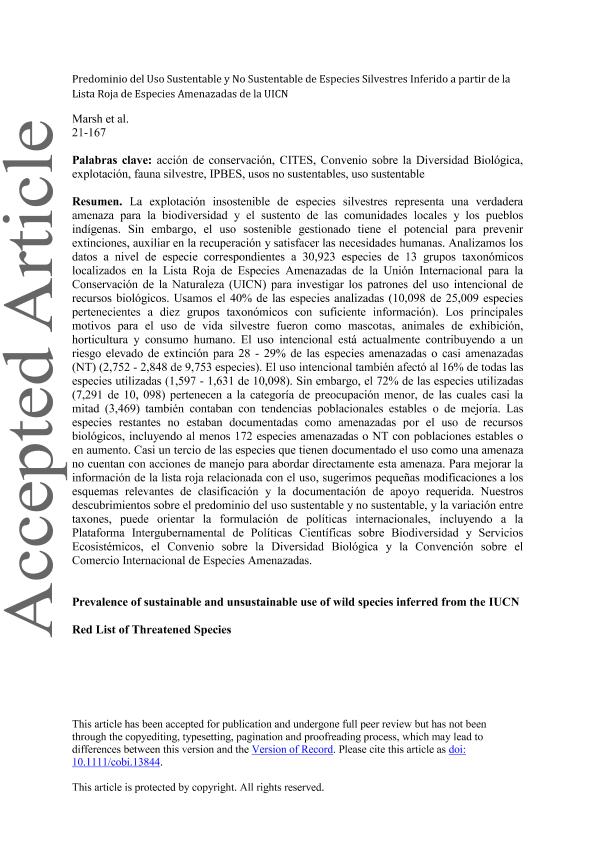Mostrar el registro sencillo del ítem
dc.contributor.author
Marsh, Sophie M. E.
dc.contributor.author
Hoffmann, Michael
dc.contributor.author
Burgess, Neil D.
dc.contributor.author
Brooks, Thomas M.
dc.contributor.author
Challender, Daniel W. S.
dc.contributor.author
Cremona, Patricia J.
dc.contributor.author
Hilton Taylor, Craig
dc.contributor.author
de Micheaux, Flore Lafaye
dc.contributor.author
Lichtenstein, Gabriela

dc.contributor.author
Roe, Dilys
dc.contributor.author
Böhm, Monika
dc.date.available
2022-08-29T18:25:50Z
dc.date.issued
2021-10
dc.identifier.citation
Marsh, Sophie M. E.; Hoffmann, Michael; Burgess, Neil D.; Brooks, Thomas M.; Challender, Daniel W. S.; et al.; Prevalence of sustainable and unsustainable use of wild species inferred from the IUCN Red List of Threatened Species; Wiley Blackwell Publishing, Inc; Conservation Biology; 36; 2; 10-2021; 1-35
dc.identifier.issn
0888-8892
dc.identifier.uri
http://hdl.handle.net/11336/166883
dc.description.abstract
Unsustainable exploitation of wild species represents a serious threat to biodiversity and to the livelihoods of local communities and Indigenous peoples. However, managed, sustainable use has the potential to forestall extinctions, aid recovery, and meet human needs. We analyzed species-level data for 30,923 species from 13 taxonomic groups on the International Union for Conservation of Nature Red List of Threatened Species to investigate patterns of intentional biological resource use. Forty percent of species (10,098 of 25,009 species from 10 data-sufficient taxonomic groups) were used. The main purposes of use were pets, display animals, horticulture, and human consumption. Intentional use is currently contributing to elevated extinction risk for 28–29% of threatened or near threatened (NT) species (2752–2848 of 9753 species). Intentional use also affected 16% of all species used (1597–1631 of 10,098). However, 72% of used species (7291 of 10,098) were least concern, of which nearly half (3469) also had stable or improving population trends. The remainder were not documented as threatened by biological resource use, including at least 172 threatened or NT species with stable or improving populations. About one-third of species that had use documented as a threat had no targeted species management actions to directly address this threat. To improve use-related red-list data, we suggest small amendments to the relevant classification schemes and required supporting documentation. Our findings on the prevalence of sustainable and unsustainable use, and variation across taxa, can inform international policy making, including the Intergovernmental Science-Policy Platform on Biodiversity and Ecosystem Services, the Convention on Biological Diversity, and the Convention on International Trade in Endangered Species.
dc.format
application/pdf
dc.language.iso
eng
dc.publisher
Wiley Blackwell Publishing, Inc

dc.rights
info:eu-repo/semantics/openAccess
dc.rights.uri
https://creativecommons.org/licenses/by-nc-sa/2.5/ar/
dc.subject
ACCIÓN DE CONSERVACIÓN
dc.subject
CITES
dc.subject
CITES
dc.subject
CONSERVATION ACTION
dc.subject
CONVENIO SOBRE LA DIVERSIDAD BIOLÓGICA
dc.subject
CONVENTION ON BIOLOGICAL DIVERSITY
dc.subject
EXPLOITATION
dc.subject
EXPLOTACIÓN
dc.subject
FAUNA SILVESTRE
dc.subject
IPBES
dc.subject
IPBES
dc.subject
SUSTAINABLE USE
dc.subject
UNSUSTAINABLE USES
dc.subject
USO SUSTENTABLE
dc.subject
USOS NO SUSTENTABLES
dc.subject
WILDLIFE
dc.subject.classification
Conservación de la Biodiversidad

dc.subject.classification
Ciencias Biológicas

dc.subject.classification
CIENCIAS NATURALES Y EXACTAS

dc.title
Prevalence of sustainable and unsustainable use of wild species inferred from the IUCN Red List of Threatened Species
dc.type
info:eu-repo/semantics/article
dc.type
info:ar-repo/semantics/artículo
dc.type
info:eu-repo/semantics/publishedVersion
dc.date.updated
2022-08-19T15:12:52Z
dc.journal.volume
36
dc.journal.number
2
dc.journal.pagination
1-35
dc.journal.pais
Reino Unido

dc.journal.ciudad
Londres
dc.description.fil
Fil: Marsh, Sophie M. E.. Colegio Universitario de Londres; Reino Unido
dc.description.fil
Fil: Hoffmann, Michael. The Zoological Society of London; Reino Unido
dc.description.fil
Fil: Burgess, Neil D.. Universidad de Copenhagen; Dinamarca. United Nations Environment Programme World Conservation Monitoring Centre; Dinamarca
dc.description.fil
Fil: Brooks, Thomas M.. University of the Philippines; Filipinas. University of Tasmania; Australia. International Union for Conservation of Nature; Suiza
dc.description.fil
Fil: Challender, Daniel W. S.. University of Oxford; Reino Unido
dc.description.fil
Fil: Cremona, Patricia J.. International Union for Conservation of Nature; Reino Unido
dc.description.fil
Fil: Hilton Taylor, Craig. International Union for Conservation of Nature; Reino Unido
dc.description.fil
Fil: de Micheaux, Flore Lafaye. Universite de Lausanne; Suiza. Institut Francais de Pondichery; India. International Union For Conservation Of Nature And Natural Resources; Suiza
dc.description.fil
Fil: Lichtenstein, Gabriela. Consejo Nacional de Investigaciones Científicas y Técnicas; Argentina. Secretaría de Cultura de la Nación. Dirección Nacional de Cultura y Museos. Instituto Nacional de Antropología y Pensamiento Latinoamericano; Argentina
dc.description.fil
Fil: Roe, Dilys. International Institute For Environment And Development; Reino Unido
dc.description.fil
Fil: Böhm, Monika. Zoological Society Of London Institute Of Zoology; Reino Unido
dc.journal.title
Conservation Biology

dc.relation.alternativeid
info:eu-repo/semantics/altIdentifier/url/https://onlinelibrary.wiley.com/doi/10.1111/cobi.13844
dc.relation.alternativeid
info:eu-repo/semantics/altIdentifier/doi/http://dx.doi.org/10.1111/cobi.13844
Archivos asociados
